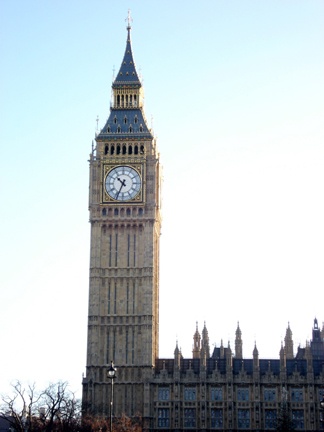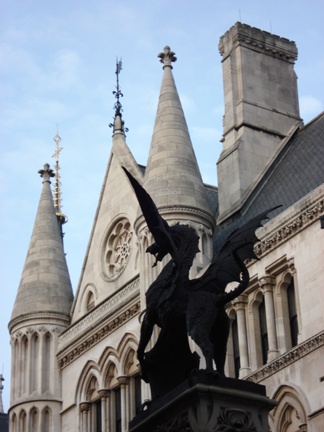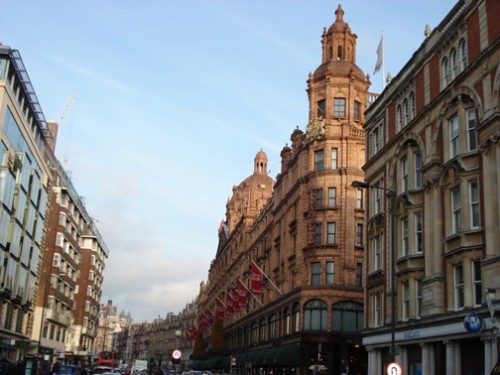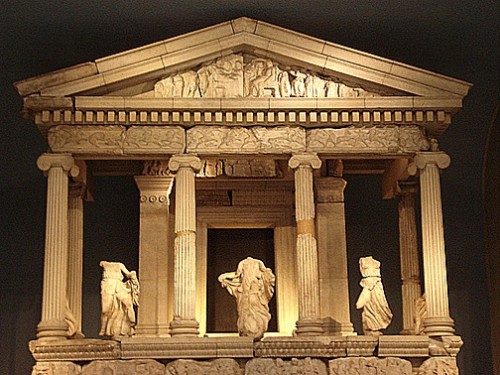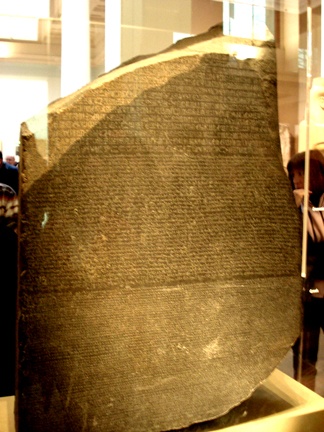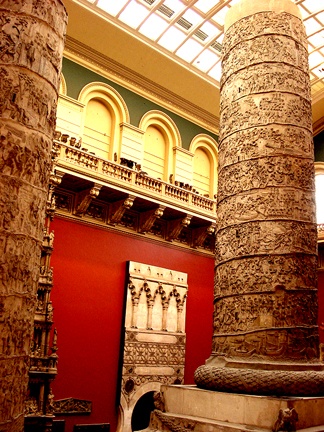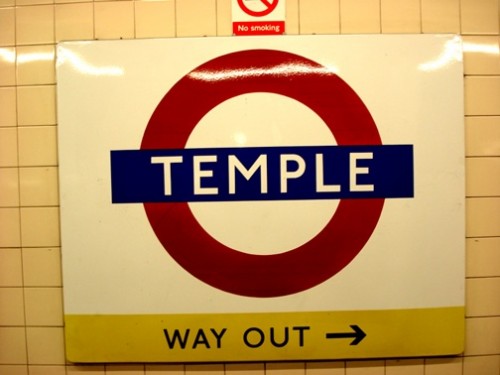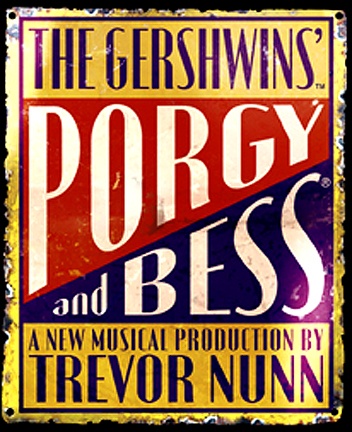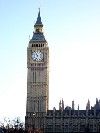London Report: Day Two
Multidigital Man, Sore Feet, British Museum, V&A, Harrods Annual Sale, Porgy and Bess
By: Mark Favermann - Jan 11, 2007
On the second day, I got up early but let my daughter sleep a little longer and later had breakfast with her. I wanted to take pictures of the dragon statue at the Inns of Court a couple of blocks from our hotel. There are not many traditional dragons in Boston, so I love looking at them when I can find them. After taking a couple of pictures, I decided to buy day passes for the Tube, so I walked down to the Temple Subway Station. At the window, there was an older woman in front of me trying to cash in a pile of 2£ certificates. This took so long that the woman apologized as a line formed behind me. The clerk kept counting them over and over. I noticed something very strange about his left hand---he had six fingers, an extra thumb. No wonder it was hard for him to count. I had never seen anyone with six fingers before.
The next window opened, and thankfully the clerk there had only five fingers. He helped me to efficiently get the day passes. I met my daughter back at the hotel lobby. She had gone looking for me and saw the dragon as well. I told her the story of the six-fingered man, and she made a face as only a 19 yr old women can at her 50-something father. Clearly, I was not PC enough speaking about this poor man's lack of conformity. Or is it his nonhomogeneous anatomy? I was a little freaked out. However, I attached no mystical connection to the six-fingered transit clerk. The dragon had more mystical meaning to me –Saint George, Arthur Pendragon, etc. We ate breakfast and then walked back to the subway.
We set out for the British Museum taking the District Line to the Northern Line. Walking through the Tube went on for what seemed like miles. My legs and arches screamed. We got off at Tottenham Court Road. We also needed to stop for a memory card for the new digital camera that we bought for the trip. This procedure was rather painless. Surprisingly, the memory stick actually seems to cost about what it would in the states. Approaching the British Museum, while walking we saw bits and pieces of Bloomsbury. I mentioned this to my daughter and spoke a little about Virginia and Leonard Woolf as well as John Maynard Keynes. As an economics concentrator, she was more impressed with Keynes than the Woolfs. Oh well.
Entering the British Museum, I tried to turn right into the British Library to see Magna Carta, Shakespeare's signatures, and John Lennon's cartooned lyrics. I was excited about sharing these pieces of written history with my daughter. However, the door was locked. I had forgotten that the British Library had been moved several years ago, in fact in 1998. Anyway, there were still great wonders to see at the British Museum. Since I had last visited, there was a very contemporary central sky-lit space, The Great Court, which had been brightly integrated into the museum. We decided to approach our visit in a directed manner. As my daughter had been studying Greek Heroes this past semester, and I had visited Egypt three years ago, the controversial Elgin Marbles and Rosetta Stone seemed like good things to see.
Certainly things have changed for the better at the British Museum. Exhibitions and object placement were now equal to anything in the world. The objects themselves have always been spectacular, but now they were presented at the same world-class level. The Egyptian exhibit was presented spectacularly. Great works were set as elegant giant sculptures. The Rosetta Stone was now under glass. I remember 20 years ago being able to touch it. Crowds of foreign tourists were clamoring to take its picture. I guess that one could consider my daughter a foreign visitor. Adjacent exhibits included perhaps my favorite heroic sculptures—the man-beasts from Assyria.
Eventually, we wandered into the classical Greek section and viewed great works taken from the Parthenon and other monuments and temples. The Brits were not all evil in this endeavor in that the Ottoman Empire controlled Greece for several hundred years and allowed Lord Elgin to save the friezes for Western Civilization. Perhaps, a deal can be struck between the English and the Greeks similar to the one that the MFA has done with the Italian Government regarding stolen masterworks. However, the British still feel that they took the Greek treasures legitimately by being given them by the Turks. Regardless of provenance, the friezes are exquisite as were the other Greek sculptures.
Getting our fill of classicism, we decided to find the tube stop for the British Library. As there are relatively few signs, we walked through Bloomsbury not knowing where we were exactly headed. The more I walked, the more pain I felt in my legs and arches. I estimate the pain in my legs was somewhere near DefCom 4 and Warp Speed 5. The Russell Square Tube Station required even more walking. After seemingly a long march of several miles, we got to the right train and then went to the King's Cross/St. Pancreas Station for the British Library. The brick building was a place that I had never been before. My daughter found the British Literary Treasures Room, and we walked (I hobbled) up a few steps and turned left.
They were all there: illuminated manuscripts, musical notations, Dickens handwritten notes, the Order for the Charge of the Light Brigade, Shakespeare's signature, Wordsworth lines, Handel's Messiah, John Lennon's words and pictures, etc. and Magna Carta in its various forms. The only problem for me was the low light. I found that to protect the documents from damage, my eyes were not allowed to read anything comfortably. Anyway, being in the presence of greatness was uplifting even if rather unreadable. Then, it was a great and painful slog back to St. Pancreas Station and on to the Victoria & Albert Museum.
After walking more than I remember on bivouac in basic training in the army, we finally got on the appropriate train to South Kensington to visit, The Attic of the Empire, the Victoria & Albert Museum. As we walked from the tube station and saw the highly ornate Science Museum, I was reminded of a particular lunch there some 23 years ago that may have been the worst meal that I ever ate in my life. No, it was the worst meal that I ever ate. It haunts me to this day as I am still a little gun-shy at eating lunch in museums.
We got to the V&A and started to look for the fashion and the design galleries. Signs seem to be an afterthought at the V&A. This lack of directional graphics is sort of like shopping malls were in the 1980's when the owners wanted you to wander around and see everything even though you wanted to buy only a couple of pairs of Jockey shorts. The fashion section was strangely easy to find. There was a Mary Quant type of 60's exhibit with Marimekko fabric outfits and psychedelic looking accessories along with cast-offs from very rich men and women from over the past two or three centuries.
One of the points of the V&A trip was to visit the chronological modern design exhibit. This was somewhere past the Silver exhibit. We asked a very pleasant guard who seemed to smirk and inform us that we were certainly on the right floor but we had to go past the library through the Silver Collection. Then we would find it. After a walk about as long as the Bataan Death March, we got to a dead-end and saw no sign of the design exhibit. My daughter started to backtrack through the Silver. I reconnoitered the rooms on the left and somehow discovered what we were looking for with no thanks to signs or directions. The exhibit was good not great, but the Welles Coates 1933 Radio and the white Zephyr lighter were fine examples of my beloved, albeit highly English (think Hercule Poirot 1920's-30's sets), Art Deco design.
I tottered down the stairs and really (right!) looked forward to walking to Harrods, only a few interminably long blocks down Brompton Road. As we approached perhaps the greatest department store in the world, there seemed to a darkening around the entrances. This was somewhat like ants attacking a dropped piece of chocolate cake at a picnic. The darkness was the hoards of shoppers emigrating from the southern countries of the European Union and the punters on daytrips from the hinter lands of the UK. We added two mistaken Americans to the sales lists.
We happened upon a retail piece of natural selection or at least human catharsis. Like the swallows returning to Capistrano or the Hadj to Mecca, the first day of Harrods' sales is an annual pilgrimage for the rapacious and rabid bargain hunters. We were soon swept up in a slowly moving sea of humanity being floated to and fro on the wake of the various retail departments. Somehow, my daughter was able to touch islands of retail goods here and there, but her search came up empty. With some fancy sidestepping, we did make it into the vaunted Harrods' Food Halls warming ourselves over the brightly lit showcases of delicacies and goodies. We decided to each have a fruit gelato at the ice cream counter. This allowed me to legally lessen the excruciating pain on my overused legs by sitting down for about seven minutes.
Refreshed, we worked our way out to the front of the store as another wave of buyers attempted to push its way in. Later that day, we were told that the security guards started to give out numbers for entrance to the store. Heading toward the tube station, we discovered that due to the swelling crowds, we were not allowed to enter and had to walk to the next station entrance several blocks down. Oh, my aching legs! On the way, my daughter made a stop at The Body Shop and Burberry's with no positive results. We finally located the station entrance and set our sites on Westminster Abbey and Parliament Square. A few stops up, we were deposited only several staircases and walkways from our destination. Though it was mid-afternoon, the sun was strangely still lighting up the sky. This is remarkable for late December in London.
Taking pictures as we walked, daughter and father crossed the street to Westminster Abbey. In front of the main door, a tasteful sign informed us that during Christmas and New years, the hours for visitation were severely curtailed. The latest visitors could enter was 1:45 PM. As it was after 3 PM, we were kind of bummed out, however, we decided to make the best of it and take pictures of the cathedral and Big Ben. My daughter even wanted a picture of her with a Bobby. She explained that she was a tourist on this trip.
Eventually, we decided to go back to our hotel to rest before the show that night. Finding our way to another subway line, we rode two stops to the Temple station. When we entered the lobby of the hotel, I went over to the concierge and asked about a cost-effective tasty Indian restaurant. He conferred with the doorman, and they both agreed on the India Club Restaurant. They said that the ambience was 1940's, with little or no charm, but the food was quite good. It was just a short walk from the hotel to the dowdy Strand Continental Hotel, the home of the India Club Restaurant.
A little background: although I was in pain due to all the London walking, my daughter was quite fatigued. So, she took a great deal of time to revive herself before going to dinner. I was concerned that we could not eat and make it to the 7:30 curtain. So, there was a bit of agonizing quick-march from our hotel to the India Club. We entered the Strand Continental and saw old fashioned signs pointing up the stairs to the India Club. The stairs, even when new, were not conducive to quick steps. We walked the two flights and arrived at the misnamed India Club.
The linoleum flooring had seen better days about 60 years ago. With worn formica tables, tinny cutlery, the place hasn't been redecorated since before the Indian/ Pakistan Partition of 1946. Yet, the waiters were very cordial, the food was surprisingly good and the experience was, to say the least, unique. Apparently, those who know consider it a vestige of the Raj. The India Club has Southern Indian Cuisine that is basic and good with no frills. The price was right and so was the food. I would recommend it to those who can get over seedy, threadbare and dingy surroundings. Its pretense was its total lack of pretense. We finished in time to get to the Savoy Theatre (also on the Strand) with at least five minutes to spare.
The Savoy Theatre was built in 1881 by Richard D'Oyly Carte to showcase Gilbert and Sullivan productions. It was the first theatre and first public space in the world to be lit by electricity. In 1929, Rupert D'Oyly Carte , Richard's son, rebuilt the theatre in an Art Deco style. A fire in the 1990's destroyed much of the theatre, but it was restored to preserve the Art Deco designs of Frank A. Tugwell and Basil Ionides from the 1929 design. It seats over 1100 people.
George Gershwin's Porgy and Bess: The Musical directed by Trevor Nunn premiered November 9, 2006 at the Savoy. Many people think they know about the show, Porgy and Bess, but they don't. For instance, Old Man River is sung in Showboat, not Porgy and Bess. Two of its greatest songs are Summertime and It Ain't Necessarily So. With music written by George Gershwin with libretto by DuBose Heyward (who wrote the best-selling novel, Porgy, in 1926) and lyrics by Ira Gershwin, Porgy and Bess is the story of a crippled (now PC handicapped) black man, Porgy, living in the slums of Charleston, South Carolina, who tries to rescue Bess, a once loose woman, from Crown, her pimp and Sportin' Life, her drug dealer. It was first performed in 1935 during the Depression and has always been controversial. It was not accepted in the United States as a legitimate opera until the late 1970's-early 1980's. Due to its negative stereotypes and undignified black dialect, some individuals and groups have considered it racist since it was first performed.
Though the 1959 film version was critically condemned, the show was occasionally performed over the years mostly outside the US. However, the show languished during the 60's and 70's due to its general perception of it as condescendingly racist during a racially-sensitive time period. Things changed in 1976 when the Houston Grand Opera performed it as an opera rather than as a Broadway show. This production was based upon Gershwin's original musical concept and restored cuts that he had made before its premiere. After this Tony award-winning effort, the public was allowed to view it as an operatic whole first envisioned by George Gershwin. The Metropolitan Opera Company staged it in 1985.
The racist controversy around the show stems from the stereotypes of the black whore , the pimp bully and the drug dealer/gambler along with the "Uncle Tom" Porgy and other figures all speaking in dialect. The use of the N-word is rather consistent. Sensitivity by black performers to it varies in direct proportion in regard to interpretation of the show as a historical music document or as a piece of Americana. The show is now considered a classic American production. It has given voice to numerous black performers and eventual stars.
Trevor Nunn's current adaptation at the Savoy includes fitting the lengthy opera into a musical theatre production. Working with the Gershwin estate, Nunn used dialogue from the original novel by Heyward and subsequent Broadway stage play to create more naturalistic scenes. This particular production was beautifully designed and the voices were for the most part strong and vibrant. Each character stood out individually. Clarke Peters is a superb and physically compelling Porgy while Nicola Hughes is a rather sexy and believable Bess. O-T Fagbenle played his character as a highly unlikable Sportin' Life while Cornel S. John's Crown was powerfully vile. Other supporting cast members in the large cast were skillful. The show was beautifully choreographed. Not knowing exactly what to expect, my daughter and I both enjoyed it.
Walking on hurting legs, I arrived back at the hotel and quickly plopped into bed and slept soundly not ever dreaming of either dragons or six-finger transit clerks or Harrod's waves of marauding hoards of shoppers.

